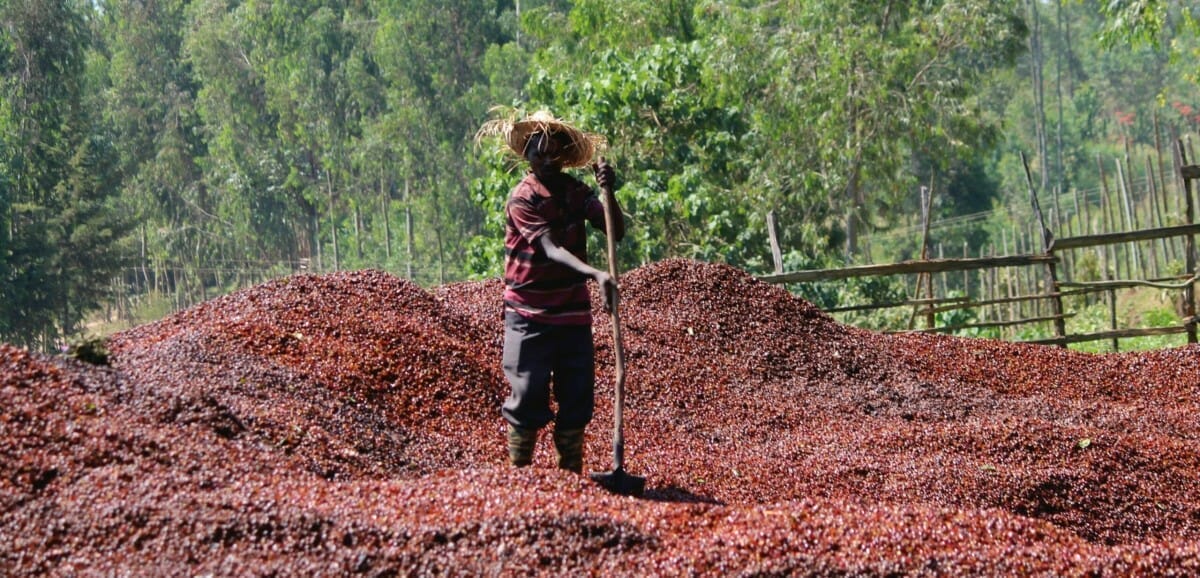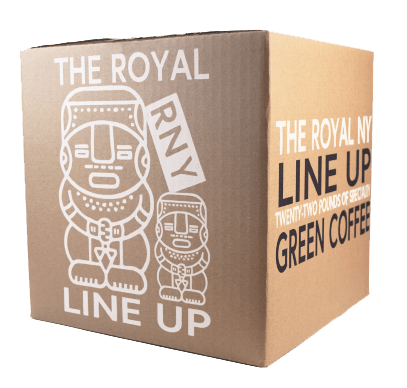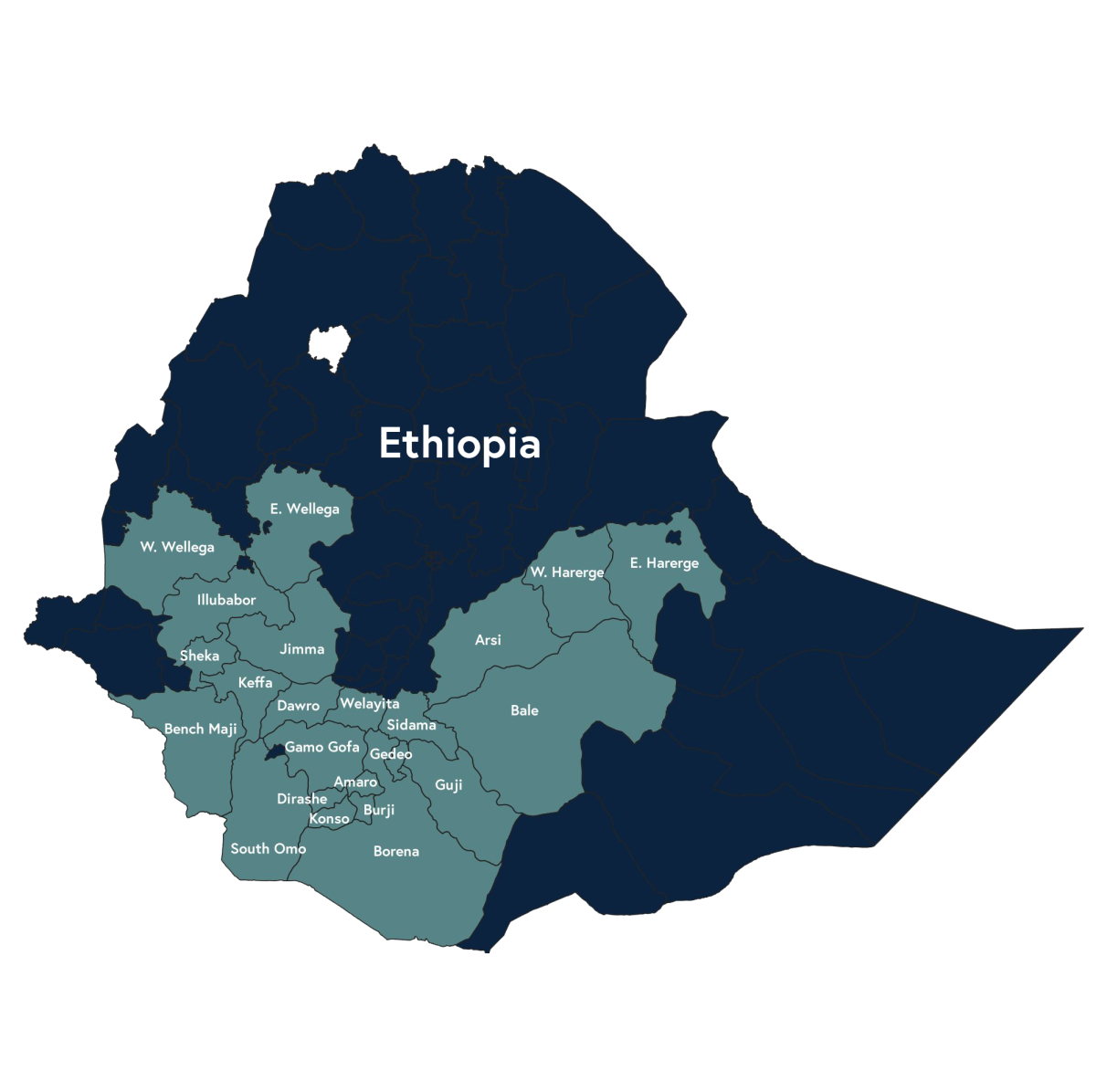No products in the cart.

Origin Profile: Ethiopia
Ethiopia is the birthplace of coffee. It is one of the largest producers of Arabica and the flavors range from rich and earthy to vibrant and complex.
| Harvest | November - February |
| Arrival | April - August |
| Number of Producers | ~4.5 million |
| Average Farm Size | <1 Hectare |
| Annual Production | 7.4 million 60-Kilo Bags |
| Common Varieties | 1,000-10,000 indigenous varieties |
| Grades | Gr. 1 - Highest Cup score and lowest defect count
Gr. 2 - Most common grade for specialty washed coffees Gr. 3 - In some cases, the highest cup score for Natural Processed coffee Gr. 4 - Lower cup score and higher defect count |
| Yirgacheffe | The Yirgacheffee Woreda (District) is found within the Gedeo Zone, but the Yirgacheffe Coffee Growing Area includes surrounding Woredas that exhibit the floral, sweet, and stone-fruity flavor profile characteristic of a coffee from Yirgacheffe like Kochere, Galena, Abaya, and Wenago |
| Sidama | Largely known for its naturally processed coffees, Sidama is increasingly producing washed coffee as well. The Sidama Coffee Growing Area includes areas surrounding the Gedeo Zone to the North, West, and East. |
| Limu and Jimma | The western regions of the country produce mostly naturally processed coffees with some lower quality washed coffees. Coffee labeled Limu may come from the woredas W./E. Wellaga and Illubador. |
| Harrar | The most Eastern coffee growing region is lower-lying and more arid. The natural processing method is dominant, but recently, coffee production in Harrar has declined in volume and quality. Harrar coffee may come from West or East Harerge |
| Data Based on MY2019/2020 | |
Ethiopia is the birthplace of coffee and it still accounts for 99% of the genetic diversity in coffee varieties. This wide range of varieties, coupled with high elevation and advanced processing methods, result in Ethiopian coffee’s exotic and complex flavors ranging from fruity and floral to sweet and earthy.
The people’s history of coffee in Ethiopia begins over 1,000 years ago. The most commonly told legend involves Kaldi the goat herder. Upon noticing the energy his flock gained after feeding upon the berries of the coffee tree, Kaldi tried them himself. He experienced alertness and euphoria and brought the cherries back to the monks in his village. They declared the cherries satanic and cast them into the fire. Upon smelling the fragrance, the beans were raked from the fire and crushed to be extinguished. They were tossed into hot water and covered. The monks sampled the resulting brew and drank it through the night.
What is more certain is that the original consumers of coffee were the ancestors of the Kaffa province. Historians believe that hunters would chew the cherries for hours as a source of energy on long journeys. This tradition later shifted to mixing the ground coffee with animal fats or ghee as a form of early energy bar. Eating the coffee became less popular as people discovered the ability to make it into a beverage. Some fermented the cherries into wine, while others roasted the seeds and crushed them. They boiled the coffee and consumed the resulting brew. Coffee began to be traded outside of Africa in the 16th century when Somali merchants brought the coffee to the port of Mocha in Yemen before spreading around the world.
Ethiopia is one of the only places where coffee grows wild. Approximately 85% of Ethiopia’s coffee is produced by small farmers on less than 1 hectare of land. Coffee harvesting can be divided into 4 categories – forest, semi-forest, garden, or estate. Forested coffee represents truly wild coffee that is unmaintained and has no owner. Semi-forested coffee represents coffee that is wild grown, but the area is now maintained by a local farmer in the form of weeding or pruning. Garden coffee has been planted and is maintained generally in the vicinity of the farmers residence alongside crops like false banana and papaya. They use traditional practices for fertilization and pest control that are organic in nature but generally lack the Organic certification because of barriers related to cost and infrastructure. Estate coffee represents the smallest part of the Ethiopian coffee economy. These estates are owned and operated by the government, by foreign investors, or in some cases Ethiopian families. They would be the most at risk for exposure to chemical fertilizers or pesticides.
JARC is the Jimma Agricultural Research Center. Founded in 1966 with the primary goal of improving Ethiopian coffee production and coordinating research at a national level, it has expanded to include two sub centers and three research stations. After a Coffee Borer Disease outbreak in 1971, the center refocused on the development and proliferation of resistant cultivars. It does this through collection and classification of landrace varieties and cross breeding programs. JARC also provides information and support for farmers in the form of best growing practices and technological advances.
Ethiopia is divided into Regions, Zones, Woredas (districts), and Kebele (villages). The Primary coffee growing regions in Ethiopia are the SNNPR or Southern Nations, Nationalities, and People’s Region and the Oromia Region. Typically, coffees will be referred to by the Zone, Woreda, or Kebele. Jimma and Guji are zones within the Oromia Region. Yirgacheffe, Kochere, and Wenago are all Woredas within the Gedeo Zone of the Southern Nations, Nationalities and People’s region. Sidama is also a zone within SNNPR. That being said, the coffee may be labeled based on flavor characteristics associated with the trademarked names of other places or with names of the cooperatives they are sold to which may lead to confusion. Mostly commonly, these areas are Yirgacheffe, Sidama, Limu, Harrar, and Jimma. Each coffee is also labeled with a grade based on quality and cup cleanliness. Cup cleanliness can be defined by processing style and defect count. Traditionally, washed coffees would be assigned a grade of 1-3 with Grade 1 coffees being the highest grade and therefore highest quality. Natural or Dry processed coffees would generally be assigned grades 3 – 5. High quality naturals will still be given a Grade of 1 or 2 if they meet the cup score requirements and maximum defect count threshold. There are also lower quality washed coffees given grades 3-5.
The ECX was designed in order to provide better price discovery/transparency and pass further value onto the producers. The aim was to set up standards and infrastructure that were more inclusive and reliable. The previous model for trading coffee involved farmers selling their product to collectors who would pass the coffee along to warehousers before being sold to a miller/exporter. The current model cuts out more of the middle men with local and accessible ECX collection warehouses. There was previously dubious transactions where farmers would not be paid for extended periods of time or quality was advertised as considerably greater than what would be received by exporters. The ECX is designed for impartial anaylsis of commodities and pricing. Purchasing coffee from Ethiopia can follow 3 major pathways 1. Direct Trade with Large Estates outside of the ECX 2. Direct Trade with a Cooperative Union at various levels of traceability depending on the cooperative outside of the ECX 3. From an Exporter who can only purchase coffees through the ECX Cooperatives have a varied history in Ethiopia. Under a Marxist government in the 1970s and 80s, they were heavily encouraged as the government saw them as fundamental in spreading their Marxist policies. They received priority access to resources and capital as well as assistance with irrigation and transportation of goods. Following the downfall of the Derg, these cooperatives fell apart without settling debts or other obligations. Under the current republic, cooperatives operate under a more clearly defined and accepted legal framework to encourage their adoption and membership, which is voluntary. Cooperative Unions, or secondary cooperatives, were formed with the help of VOCA and USAID to create larger networks of farmers to increase access to resources and knowledge with the goal of decreasing poverty.
In the face of conflict and other adversities, farmers are looking for more efficient ways to make a living. Khat is an addictive plant that is chewed to produce amphetamine-like effects. Khat began to be consumed primarily by Sufis during the long prayer sessions in the 11th century. Today some estimate that 20% of Ethiopians chew the herb. Consumption can be up to 1lb in a single day, and average cost is about $4 per day where average income is <$800 annually. Khat production is especially high in the Harrar region in the east of the country.
The people’s history of coffee in Ethiopia begins over 1,000 years ago. The most commonly told legend involves Kaldi the goat herder. Upon noticing the energy his flock gained after feeding upon the berries of the coffee tree, Kaldi tried them himself. He experienced alertness and euphoria and brought the cherries back to the monks in his village. They declared the cherries satanic and cast them into the fire. Upon smelling the fragrance, the beans were raked from the fire and crushed to be extinguished. They were tossed into hot water and covered. The monks sampled the resulting brew and drank it through the night.
What is more certain is that the original consumers of coffee were the ancestors of the Kaffa province. Historians believe that hunters would chew the cherries for hours as a source of energy on long journeys. This tradition later shifted to mixing the ground coffee with animal fats or ghee as a form of early energy bar. Eating the coffee became less popular as people discovered the ability to make it into a beverage. Some fermented the cherries into wine, while others roasted the seeds and crushed them. They boiled the coffee and consumed the resulting brew. Coffee began to be traded outside of Africa in the 16th century when Somali merchants brought the coffee to the port of Mocha in Yemen before spreading around the world.
Ethiopia is one of the only places where coffee grows wild. Approximately 85% of Ethiopia’s coffee is produced by small farmers on less than 1 hectare of land. Coffee harvesting can be divided into 4 categories – forest, semi-forest, garden, or estate. Forested coffee represents truly wild coffee that is unmaintained and has no owner. Semi-forested coffee represents coffee that is wild grown, but the area is now maintained by a local farmer in the form of weeding or pruning. Garden coffee has been planted and is maintained generally in the vicinity of the farmers residence alongside crops like false banana and papaya. They use traditional practices for fertilization and pest control that are organic in nature but generally lack the Organic certification because of barriers related to cost and infrastructure. Estate coffee represents the smallest part of the Ethiopian coffee economy. These estates are owned and operated by the government, by foreign investors, or in some cases Ethiopian families. They would be the most at risk for exposure to chemical fertilizers or pesticides.
JARC is the Jimma Agricultural Research Center. Founded in 1966 with the primary goal of improving Ethiopian coffee production and coordinating research at a national level, it has expanded to include two sub centers and three research stations. After a Coffee Borer Disease outbreak in 1971, the center refocused on the development and proliferation of resistant cultivars. It does this through collection and classification of landrace varieties and cross breeding programs. JARC also provides information and support for farmers in the form of best growing practices and technological advances.
Ethiopia is divided into Regions, Zones, Woredas (districts), and Kebele (villages). The Primary coffee growing regions in Ethiopia are the SNNPR or Southern Nations, Nationalities, and People’s Region and the Oromia Region. Typically, coffees will be referred to by the Zone, Woreda, or Kebele. Jimma and Guji are zones within the Oromia Region. Yirgacheffe, Kochere, and Wenago are all Woredas within the Gedeo Zone of the Southern Nations, Nationalities and People’s region. Sidama is also a zone within SNNPR. That being said, the coffee may be labeled based on flavor characteristics associated with the trademarked names of other places or with names of the cooperatives they are sold to which may lead to confusion. Mostly commonly, these areas are Yirgacheffe, Sidama, Limu, Harrar, and Jimma. Each coffee is also labeled with a grade based on quality and cup cleanliness. Cup cleanliness can be defined by processing style and defect count. Traditionally, washed coffees would be assigned a grade of 1-3 with Grade 1 coffees being the highest grade and therefore highest quality. Natural or Dry processed coffees would generally be assigned grades 3 – 5. High quality naturals will still be given a Grade of 1 or 2 if they meet the cup score requirements and maximum defect count threshold. There are also lower quality washed coffees given grades 3-5.
The ECX was designed in order to provide better price discovery/transparency and pass further value onto the producers. The aim was to set up standards and infrastructure that were more inclusive and reliable. The previous model for trading coffee involved farmers selling their product to collectors who would pass the coffee along to warehousers before being sold to a miller/exporter. The current model cuts out more of the middle men with local and accessible ECX collection warehouses. There was previously dubious transactions where farmers would not be paid for extended periods of time or quality was advertised as considerably greater than what would be received by exporters. The ECX is designed for impartial anaylsis of commodities and pricing. Purchasing coffee from Ethiopia can follow 3 major pathways 1. Direct Trade with Large Estates outside of the ECX 2. Direct Trade with a Cooperative Union at various levels of traceability depending on the cooperative outside of the ECX 3. From an Exporter who can only purchase coffees through the ECX Cooperatives have a varied history in Ethiopia. Under a Marxist government in the 1970s and 80s, they were heavily encouraged as the government saw them as fundamental in spreading their Marxist policies. They received priority access to resources and capital as well as assistance with irrigation and transportation of goods. Following the downfall of the Derg, these cooperatives fell apart without settling debts or other obligations. Under the current republic, cooperatives operate under a more clearly defined and accepted legal framework to encourage their adoption and membership, which is voluntary. Cooperative Unions, or secondary cooperatives, were formed with the help of VOCA and USAID to create larger networks of farmers to increase access to resources and knowledge with the goal of decreasing poverty.
In the face of conflict and other adversities, farmers are looking for more efficient ways to make a living. Khat is an addictive plant that is chewed to produce amphetamine-like effects. Khat began to be consumed primarily by Sufis during the long prayer sessions in the 11th century. Today some estimate that 20% of Ethiopians chew the herb. Consumption can be up to 1lb in a single day, and average cost is about $4 per day where average income is <$800 annually. Khat production is especially high in the Harrar region in the east of the country.




